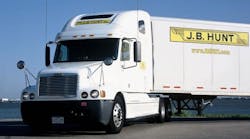Trucking industry reports indicate capacity continues to tighten, and significant freight rate increases are expected in the coming months.
Recent hurricanes, the pending electronic logging device (ELD) mandate, and an uptick in overall freight demand has “unquestionably” given trucking fleets the upper hand in 2018 negotiations, according to a report from analyst Jason Seidl of Cowen and Co.
The report said private fleets and third-party logistics firms are “as bullish as we’ve ever heard,” with rate increases possibly reaching 15 percent.
Seidl said one 3PL has informed a customer it will not honor a rate agreement from the spring because “the market has moved so significantly since then.”
John Larkin of Stifel noted that in recent weeks truckload volumes and spot rates have remained strong, and “contract rates began to move in the positive direction for the first time in a year and a half."
The report from Cowen called the spot market as hot as any time in the past three years, and for truckload carriers, the higher pricing translates into stronger rates on contract freight.
A letter obtained by Fleet Owner from J.B. Hunt Transport Services informed customers to prepare for rate hikes.
“This is one of the highest periods of turbulence and volatility in supply we’ve ever experienced, and we don’t think it will abate anytime soon. We predict our cost environment will be fluid and more responsive to the supply of drivers and capacity, as well as the additional constraints anticipated by the upcoming ELD mandate. With the expected impact of these conditions, we advise budgeting for transportation cost increases that may reach 10 percent or more," the Hunt letter said.
On the less-than-truckload side, volumes have been “up significantly” with some truckload overflow freight, industrial sector strength, and continued growth in the e-commerce sector.
In another report, IHS Markit said while spot rates have stabilized since the hurricanes, they remain elevated.
“Tightening in freight capacity, even before the hurricanes hit, will have an effect on increased transportation costs in the third and fourth quarters of 2017,” IHS said. “Demand for flatbed and specialized trucks will increase.”
One result of the rate increases, Larkin said, could be increases in driver pay between 5 percent and 7.5 percent.
Growing market optimism was also evident in FTR’s preliminary September report on trailer orders, which came in at 21,500 units, up 47 percent from August and 84 percent from a year earlier.
“When fleets begin ordering more trailers in September, it indicates the market should be robust the following year,” said Don Ake, FTR’s vice president of commercial vehicles. “Freight expansion early next year will severely strain industry capacity, and fleets will need to add trailers to handle the added loads.”



